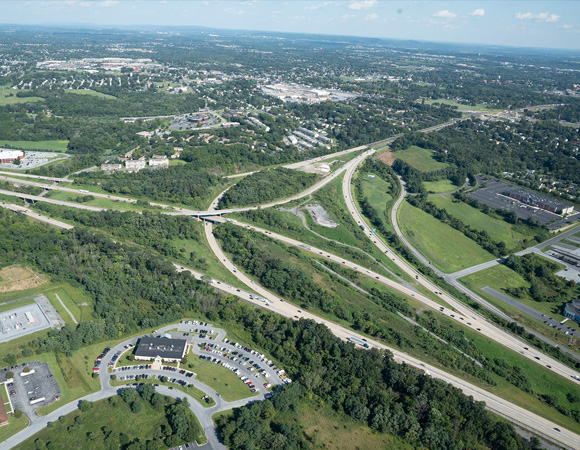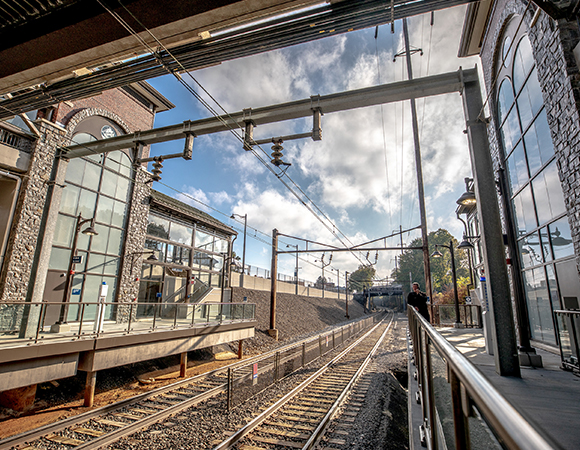The Pennsylvania State Transportation Commission (STC) serves as the Pennsylvania Department of Transportation’s (PennDOT) board of directors. The 15-member board evaluates the condition and performance of Pennsylvania’s transportation system and assesses the resources required to maintain, improve, and expand transportation facilities and services. State Law requires PennDOT to update Pennsylvania’s 12-Year Transportation Program (TYP) every two years for submission to the STC for adoption.

The 12-Year Program, or TYP, identifies and prioritizes transportation projects and assigns funding to complete them over 12 years. The TYP is updated every two years through a partnership of PennDOT, the State Transportation Commission, regional Metropolitan and Rural Planning Organizations, and many other transportation stakeholders and citizens throughout the state. The TYP would not be complete without the projects and ideas submitted by the users of our transportation infrastructure.
The goal of the TYP is to ensure safe and reliable travel across our Commonwealth while promoting a dependable and efficient system for moving goods throughout Pennsylvania. The TYP includes funding for highways and bridges, public transit, rail freight, aviation, and bicycle and pedestrian facilities.
The TYP incorporates the historic federal investment in transportation infrastructure, the Bipartisan Infrastructure Law (BIL). These funds will help improve Pennsylvania’s roadways and bridges, enhance public transportation options, expand electric vehicle charging infrastructure, and adapt our transportation system to the challenges of extreme weather events and climate change.
We highlight several accomplishments and initiatives underway, including our focus on equity and inclusion within PennDOT and our approach to community engagement. We also feature updates on our use of technology, the growth of electric vehicles, and the approaching deadline for REAL ID.
The TYP also discusses PennDOT’s response to COVID-19 and how we continue recovering from the pandemic while ensuring we can plan and adapt to the future.
The work we are doing today will provide a better transportation system for all Pennsylvanians well beyond today. I encourage you to find out more, especially about projects in your area, by reviewing the 2023 TYP.

In addition to establishing PennDOT and the STC, Act 120 of 1970 also created the Transportation Advisory Committee (TAC). The 30-member TAC is comprised of 18 members of the public, four members of the Pennsylvania Legislature, and leaders from several state agencies.
The TAC conducts in-depth studies on key transportation issues to advise the planning process, including the biennial Transportation Performance Report (TPR).
Transportation projects listed in the 12-Year Program (TYP) use a combination of federal, state, and local funding. The available amounts over the 12 years reflect anticipated financial investments based upon legislation, actual and anticipated budgets, and historical trends.
On November 15, 2021, the Infrastructure Investment and Jobs Act (IIJA) was signed into law. This legislation, also known as the Bipartisan Infrastructure Law (BIL), provides federal funding for highways, bridges, and public transit for the first four years of the TYP. The passage of the law reauthorized many funding categories at higher levels than the previous legislation, the Fixing America’s Surface Transportation (FAST) Act, while establishing new funding programs that provide for increased investment in bridges, the reduction of transportation emissions, strengthening transportation infrastructure against extreme weather and natural disasters, and electric vehicle charging infrastructure. The TYP assumes federal funding levels will remain flat, at 2026 levels, throughout the remaining eight years of the program.
Legislation such as the IIJA sets the level of federal funding and assigns this funding to specific uses or programs. In addition to the new categories mentioned above, the TYP also includes funds designated for use in other programs for highways and bridges. Examples include:
Within these programs, funds can further be assigned to specific categories of emphasis. For example, a certain percentage of Surface Transportation Block Grant Program funding is designated toward improvements on ‘off-system bridges’ often owned by municipalities or have lower traffic volumes. Another portion of funds in this program is set aside for areas with specific population thresholds.
The annual state budget process determines the funding amounts available for projects on the TYP through allocations from several monetary sources:
Overall funding at the state level is also uncertain throughout the TYP due to declining revenue from reduced gas tax receipts and inflationary pressures. Most of the funding provided through the IIJA requires a percentage of matching funds from other sources, such as state funding.
Local municipalities, private entities, toll authorities, and transit operators also provide funds that are accounted for in the TYP. These funds are most often included when a match is required for state or federal funds.
The 2023-2034 12-Year Program provides nearly $84 billion for all modes of transportation. The table below shows the funding distribution in millions of dollars for the first four years, the second four years, the third four years, and the total TYP.
| Program | 1st Four Years 2023 - 2026 |
2nd Four Years 2027 - 2030 |
3rd Four Years 2031 - 2034 |
Total |
|---|---|---|---|---|
| Aviation | $168 | $134 | $133 | $435 |
| Rail Freight | $232 | $232 | $231 | $695 |
| Public Transit | $11,392 | $11,969 | $13,175 | $36,536 |
| Highway/Bridge | $15,832 | $14,901 | $14,301 | $45,034 |
| Multimodal | $331 | $345 | $360 | $1,036 |
| Total | $27,955 | $27,581 | $28,200 | $83,736 |
The 12-Year Program list of projects has been broken up by county to make searching easy. Please click on a county below to view the list of projects for that county. The Interstate and Statewide projects are grouped separately and can be viewed here: Interstate or Statewide. Search and click the list to view funding details.
Other resources for exploring transportation projects include: PA Transportation Projects and PennDOT One Map. For optimal experience viewing PennDOT OneMap, please use Chrome or Edge.
Multiple plans and programs are used to evaluate, set goals, select projects, and fund Pennsylvania’s transportation needs.
The projects listed in the first four years of the TYP are the federally required Statewide Transportation Improvement Program (STIP). The STIP includes the 24 individual regional TIPs representing each MPO, RPO, and one independent county. It also includes the two statewide programs: Interstate Management Program and Statewide Initiatives. Each TIP includes a list of projects with funding assigned for each year. In Pennsylvania, MPOs and RPOs update their TIPs every two years during the TYP update process. MPOs and RPOs conduct public involvement activities when developing their TIPs. The public involvement programs are defined in each region’s Public Participation Plan.
The 12-Year Transportation Program (TYP) is Pennsylvania’s official mid-range planning tool and is required by Act 120 of 1970. The TYP identifies and prioritizes projects and funding over a 12-year period. The first four years is the federally required Statewide Transportation Improvement Program (STIP) and regional Transportation Improvement Programs (TIPs).
The TYP is updated every two years in a collaborative effort between PennDOT, the STC, regional Metropolitan and Rural Planning Organizations (MPOs and RPOs), and the public. The TYP represents all modes and means of transportation including highways, bridges, public transit, aviation, and rail, as well as active transportation such as bicycling and walking.
The Statewide Long-Range Transportation Plan (LRTP) is PennDOT’s largest and most comprehensive statewide transportation plan. It covers a 20-year forecast period. The Statewide LRTP is used to develop transportation policies, visions, and goals for the Commonwealth. The TYP must align with the Statewide LRTP which is updated every six to 10 years. The 2045 Long-Range Transportation Plan was adopted in 2022, and the Freight Movement Plan (FMP) is expected to be finalized by November 2022.
Each MPO and RPO develops its own LRTP that includes a list of transportation projects based upon the amount of funding a region expects to receive over 20 years. Regional LRTPs are updated every four or five years to reflect new data and changes to regional priorities in transportation investments.
The Public Participation Plan (PPP) provides guidance on opportunities for all people to contribute to the updates of the LRTP, TYP, and STIP. Pennsylvania recently updated its PPP with the help of stakeholders throughout the state. Each MPO and RPO has its own Public Participation Plan that is regularly updated.
Transportation Performance Management (TPM) is a strategic approach that uses system information to make informed investment and policy decisions to achieve national, state, and local goals for the reliable, predictable, and safe movement of people and goods. Projects listed in the TYP are aligned with these goals to create a better performing transportation system focused on safe, connected, and productive communities.
The TYP lists projects based on:
Projects are organized by the associated MPO or RPO and further described by transportation mode and county. Transportation project costs are allocated over one or more four-year periods based on the anticipated schedule of the project. The TYP also includes line items by funding category which are typically seen in the second and third four-year program periods. As new projects are identified, the line items are adjusted to reflect the detailed phases and costs associated to advance the project, all within fiscal constraints.
PennDOT submits the TYP to the STC every two years. The STC reviews and votes to adopt the TYP. PennDOT then sends the STIP (the first four years of the TYP) to the Federal Highway Administration, the Federal Transit Administration, and the US Environmental Protection Agency for review and approval prior to the start of the federal fiscal year on October 1.
Transportation Program Development Process
12-Year Program Cycle - 2023-2034
| 2023 | 2024 | 2025 | 2026 | 2027 | 2028 | 2029 | 2030 | 2031 | 2033 | 2033 | 2034 |
|---|---|---|---|---|---|---|---|---|---|---|---|
| 1st Four Years (TIP & STIP) | 2nd Four Years | 3rd Four Years | |||||||||
| 12-Year Program (TYP) | |||||||||||
The TYP update process takes place over a two-year period, beginning with the Transportation Performance Report (TPR) that details the condition of transportation in Pennsylvania. This is immediately followed by a call to action for the public to provide feedback on transportation priorities and needs. More information on public participation is provided below.

This animated tool explains how Pennsylvania goes from transportation planning to transportation projects.
Take a RideThe Statewide Transportation Improvement Program (STIP) lists statewide planned projects and assigns funding over a four-year period. It includes the 24 regional Transportation Improvement Programs (TIPs) and two statewide-managed TIPs (Interstate Management Program TIP and Statewide Initiatives TIP). The STIP is updated every two years after the regional TIPs are submitted and approved. The Draft 2023 STIP Public Comment Period was held from June 15 through June 30, 2022.

Learn how projects included in the STIP become approved for implementation and design.
Take a TripDo you know your Metropolitan or Rural Planning Organization?
Pennsylvania's statewide transportation planning effort begins at the local level with regional plans and programs. Pennsylvania has 19 Metropolitan Planning Organizations (MPOs), four Rural Planning Organizations (RPOs), and one independent county (Wayne County).
Public involvement is an important part of the TYP update process. Every two years, the STC holds a Public Comment Period to request feedback on local, regional, and statewide transportation issues and priorities. All responses are compiled, documented, and analyzed for use in the TYP, statewide LRTP, FMP, regional TIPs, and regional LRTPs. This feedback plays a key role in the decision-making process for identifying and funding transportation projects.
This Public Comment Period was especially significant since it was held during the COVID-19 pandemic. Since public gatherings were not permitted, extra effort was required to ensure the public could still have their voices heard.
During the 2023 TYP Update Public Comment Period, 7,423 public participants completed the online transportation survey. Survey respondents identified nearly 2,500 transportation concerns – 402 of which were already targeted by PennDOT’s planned projects.
The TYP Update Public Comment Period launched on Monday, March 1, 2021, and concluded Wednesday, April 14, 2021. During this period, PennDOT and the STC engaged the public through extensive social media and email communication campaigns and hosted two key public involvement activities: the Online Public Forum and a Transportation Survey.
The STC and PennDOT are committed to an effective and inclusive public participation program. The outreach effort is evaluated following each campaign to make sure all users of Pennsylvania’s transportation system have adequate and equal opportunity to participate.
The 2021 TPR was presented to the STC on February 25, 2021, and the 2023 TYP Update Public Comment Period began shortly after, running from March 1 to April 14, 2021.
The 2023 TYP Public Outreach Campaign focused on reaching Pennsylvania transportation system users of all ages, genders, and ethnicities.
Notable outreach methods included:
The Online Public Forum was held virtually on Tuesday, March 23, 2021, airing live on Facebook Live and the PAcast.com webinar platform, in accordance with COVID-19 safety protocols. Viewers had the option to enable closed captions in English or Spanish during the broadcast, which were included in the broadcast recording and transcript posted on the TalkPATransportation website.
The virtual meeting featured the findings of the 2021 TPR followed by an interactive question and answer session. PennDOT and STC provided answers to all questions received, including those not answered during the online meeting. All questions and responses provided were posted on TalkPATransportation.com. There were 1,905 live webinar participants (assuming one person per streaming device).
There were 7,423 participants who completed the online survey. Survey respondents geographically represented every MPO and RPO region and identified nearly 2,500 transportation concerns – 402 of which were already targeted by PennDOT’s planned projects. Details for each section are provided below.
PennDOT and the STC summarized the public feedback and shared it with the MPOs and RPOs in advance of the development of their regional TIPs. The survey analysis is posted on the STC website results page.
With a continuing national discussion about racial inequity ongoing, the Department created a Dismantling Systemic Racism and Inequities Working Group, made up of employees throughout the agency, to evaluate policies and procedures and improve the inclusion and organizational culture of the Department.
The group released the first-ever Dismantling Systemic Racism and Inequities report that provided recommendations for areas including PennDOT staffing, recruitment and culture, public involvement activities, and contracting.
More specifically, PennDOT wants to increase its rate of direct involvement and engagement with communities of color.
Historically, the Department has received low engagement from this group. The Department continuously works to improve our public involvement process using demographic data to increase broader community participation and input.
Importantly, we are exploring ways to fund transportation improvements that are not as reliant on the gas tax. Pennsylvania’s state gas tax is the second highest in the nation, which significantly impacts those with low and moderate incomes. As a result, we are analyzing potential new sources of funding to better serve our communities. One example would be a revenue option to help subsidize our transit system and provide better access and savings for disadvantaged populations.
Finally, we want to make sure people of color are appropriately represented within PennDOT’s workforce, including management positions and on our advisory boards and commissions, to reflect our communities. We are looking at ways to expand and strengthen our apprenticeship program, specifically for under-represented groups in construction and maintenance areas.
These efforts become increasingly important as Pennsylvania becomes more diverse, illustrated by 2020 US Census numbers, which showed increases in non-white residents. Currently, Pennsylvania’s racial and ethnic representation identifies as 75.7% White, 12% Black, 7.8% Hispanic, and 3.8% Asian.
PennDOT is considering these diversity and inclusion efforts to make sure transportation works for everyone.
*All numbers are based on the 2020 Census
State Population: 13 million
Percentage population change: 2.4% increase
Percentage of residents over the age of 18: 79.6%
Ranking: Pennsylvania is the 5th largest state by population
Race and Origin:
White residents: 75.7%
Black residents: 12%
Hispanic residents: 7.8%
Asian residents: 3.8%
The Dismantling Systemic Racism and Inequities report findings endorsed the creation of a Director of Equitable Transportation position. The position leads the implementation of the report’s many recommendations and moves other diversity, equity, and inclusion initiatives forward.
This position helps the Department address important questions:
are we spending taxpayer dollars equitably across all communities, and can we help communities that may have fewer resources to
advocate for themselves?
PennDOT envisions a transportation system that is equitable, safe, environmentally sustainable, accessible, and affordable for all communities. This is particularly important in historically underserved and vulnerable communities. The Director of Equitable Transportation and PennDOT will work to consistently ensure that everyone is well-served by Pennsylvania’s transportation system.

PennDOT is implementing innovative strategies and embracing the latest technologies in many areas of its work to enhance safety and be more efficient. Below are some of the ways PennDOT applies high-tech tools and systems to benefit Pennsylvanians.
Staff operate drones to perform structural and construction inspections, surveying work, traffic incident management, and other tasks. The use of drones can often result in fewer hours of lane or road closures and less exposure to hazards for workers. One further example of their benefit is that staff analyze drone footage for traffic studies and use the flight’s video output to generate 3D models of construction projects. Drones even assist in calculating quantity estimates for how much ground will need to be moved for a construction project.
Importantly, drones have been deployed during natural disasters, such as flooding events, sinkholes, and landslides or when rocks fall on roadways. In one case, PennDOT closed a road to remove a teetering boulder, which was endangering the traveling public. A drone recorded the detonation and spread of the debris from the blast without any risk to department personnel.
PennDOT is implementing the use of digital data, such as three-dimensional (3D) models, into the project development process to convey the design intent of both bridge and roadway projects. The implementation of digital models will allow contractors and department staff to collaborate on challenges before and after moving into construction. Construction inspectors will use the digital models to inspect, address and document all aspects of the project. Once the project is completed, the digital data will be returned to the Department as a digital as-built to be used in the management of our assets. The Department will be able to fund additional construction projects by providing more detailed designs, therefore reducing project delivery costs and the amount of construction work orders, benefitting all Pennsylvanians.
The vision is that by the year 2025, construction projects will be bid using 3D technology and will no longer be in a traditional two-dimensional construction plan format.
The Department is currently developing a Lane Reservation System to support PennDOT’s vision of improved safety, less congestion, and more reliable traffic flow on Pennsylvania’s highways.
Pennsylvania’s Lane Reservation System will work to reduce congestion caused by work zones by ensuring that crews are performing work during the most appropriate times. Much like an online reservation system used for restaurants, work crews will need to reserve a specific time on a particular date to perform required repairs to the road and bridge network.
If they want to schedule work during a prime driving time, they may find no reservations available. When this occurs, they will need to choose a less congested time. This approach will help ensure the safety of the workers, reduce congestion on major roadways, and eliminate conflicts between other work zones in the area. The first phase is scheduled for Spring 2023, focusing on the Core Roadway Network.
As more people fly drones for recreation and work, PennDOT highlights the Unmanned Aircraft Systems (UAS) rules and regulations for their safe and lawful use.
For recreational use, individuals must take The Recreational UAS Safety Test (TRUST) and follow the Federal Aviation Administration’s (FAA) Recreational Model Aircraft Rules.
One of those rules states that if a drone weighs more than 0.55 lbs. (250g), it must be registered. Individuals must also follow specific requirements about how the drones are flown and make certain they are within their line of sight while flying.
It is important to remember that operating a drone to conduct surveillance of another person in a private place or in a way that could cause bodily harm is unlawful.
Individuals flying drones for business purposes must pass the FAA’s Aeronautical Knowledge Test to obtain a Remote Pilot Certificate.
PennDOT currently has 17 licensed UAS pilots and 20 UAS units in its central office and district engineering offices. Efforts have begun to develop a strategic plan to safely encourage UAS technology in Pennsylvania.

Pennsylvania is a national leader in supporting the growth of electric vehicles (EV) on our highways.
PennDOT is actively collaborating with federal, state, and local partners to expand the Commonwealth’s EV charging and alternative fuels network. Through the Federal Highway Administration’s (FHWA) Alternative Fuels Corridor (AFC) program, the Department is proactively planning for the build-out of fast-charging EV and alternative fuel stations, particularly along highways, to support the needs of drivers for reliable long-range and employment-related travel. PennDOT also works closely with the Pennsylvania Department of Environmental Protection (PA DEP), which leads several EV and alternative fuels initiatives and funding programs (see PA DEP’s resource page Electric Vehicles in PA) on Pennsylvania’s EV infrastructure planning and deployment.
In July 2022, the Department released the statewide EV Mobility Plan, which builds on the information and strategies presented in the PA DEP Vehicle Roadmap. PennDOT is evaluating the current state of vehicle electrification, identifying mobility challenges, and developing ways to expand our EV charging network in an equitable, sustainable, and efficient manner.
To date, the Commonwealth has designated over 1,800 miles of highway as Alternative Fuel Corridors (AFC). There are over 2,800 plugs available at over 1,200 EV charging stations.
Under the Infrastructure Investment and Jobs Act/Bipartisan Infrastructure Law (IIJA/BIL), Pennsylvania will receive $171.5 million over five years to support the expansion of a convenient, reliable, and equitable EV charging station network through the National Electric Vehicle Infrastructure (NEVI) Formula Program. PennDOT also submitted the federally required NEVI State Plan in July 2022 for access to NEVI funds.
The Pennsylvania NEVI Plan outlines PennDOT’s approach to the strategic deployment of a convenient, reliable, affordable, and equitable EV charging network to support range confidence for Pennsylvanians and visitors over the course of the NEVI Formula Program.
Per the guidance from US DOT, any EV charging infrastructure installed with NEVI formula funds shall be located along a designated AFC and meet US DOT minimum standards and requirements. Should PennDOT determine, and US DOT certifies, that the AFCs are fully built out, then Pennsylvania may use funds to build EV charging equipment on any public road or in any publicly accessible location, including but not limited to parking facilities at public buildings, public schools, and parks.
Electric Vehicles are gaining a foothold in the state’s auto market. There are over 31,000 electric vehicles registered in Pennsylvania (as of July 2022). PennDOT is planning for the new infrastructure to support this transition to meet public and industry expectations and ensure Pennsylvanians and visitors can get to their destinations safely and reliably using EVs and alternative fuels.
To meet public and industry expectations and ensure Pennsylvanians can get to their destinations safely and reliably using EVs and alternative fuels, PennDOT is planning for the new infrastructure needed to support this transition today — paving the way for the cleaner, more energy-efficient travel of the future.
Interested in knowing how many charging stations are currently in Pennsylvania and where they are located?
Burning gasoline and diesel in high-traffic intensity areas is a substantial source of air pollution. EVs have zero tailpipe emissions. Currently, the transportation sector accounts for the most greenhouse gas emissions of any other industry nationwide and is the third-highest emitter for Pennsylvania. EVs provide the Commonwealth and our nation with the opportunity to significantly cut our greenhouse gas emissions and work to combat the climate crisis. Climate change does not impact all communities equally, with poor and non-white communities hit hardest by its damaging effects.
Due to the greater fuel efficiency and lower maintenance of EVs, consumers and government fleets that switch to EVs from gasoline-powered vehicles should save on maintenance and fuel costs.
Using EVs can help Pennsylvania decrease reliance on foreign oil and increase its use of domestic fuels. The Commonwealth also could benefit from job growth. PennDOT is committed to providing EV awareness, education, and technical capacity to our partners, primarily to support EV industry job skills, local small business development, and educational opportunities for all job levels.
The price of EVs continues to decline with each passing year, with manufacturers releasing more comparable prices to that of internal combustion engine vehicles. As more EVs hit the market and Pennsylvania roads, the demand for used EVs will continue to grow, giving an option to households not looking to purchase a new vehicle. Additionally, there is funding in the BIL to support the electrification of other modes for individuals who use public transit and shared mobility.
The Commonwealth of Pennsylvania has a long history of supporting intercity passenger rail through strategic capital investments and operating assistance to provide safe and reliable passenger rail to millions of travelers annually.
In 2006, PennDOT and Amtrak completed a $145 million Keystone Corridor Improvement Program on the 104-mile Keystone Corridor between Philadelphia and Harrisburg. The improvements facilitated an increase in maximum speed to 110 mph and reduced travel time on express service to just 95 minutes, which is significantly less than the same trip by automobile. Since then, the Commonwealth has continued strategic infrastructure investments to increase speeds to 125 mph and further reduce travel time by improving track, signals, and power systems to modernize the Keystone Corridor.
Additionally, PennDOT launched the Plan the Keystone initiative to improve conditions at the 12 Keystone Corridor stations to meet ADA requirements, refurbish or replace station buildings along the line, and ensure that station improvements complement local revitalization efforts.

A new station is under construction in Coatesville. The $65 million project includes platforms with canopies, seating, stairs, elevator towers, expanded parking, a freight bypass track, and accommodation for multimodal connections.
The previous train station building was closed more than 25 years ago and could not be refurbished to comply with current ADA standards. Completion of the new station is slated for 2025.
This project will expand parking and pedestrian access to Lancaster Station to accommodate growing ridership and improve accessibility by constructing a new parking lot and new pedestrian connections between the new parking lot and the station.
Downingtown's new train station will provide full ADA accessibility with 550-foot-long high-level platforms, accommodate growing ridership, and anchor station-area redevelopment. The station will be constructed on Brandywine Avenue, less than a half-mile east of the current Downingtown Station. A new site is necessary because the current station is located on a slight track curve and cannot feasibly be modified to accommodate ADA access requirements.
There is currently one Amtrak train (the Pennsylvanian) operating each direction per day between Pittsburgh and Harrisburg on the Keystone West corridor. PennDOT initially examined options for improving passenger service on Keystone West as part of a 2011 study undertaken in cooperation with the Federal Railroad Administration (FRA) and Norfolk Southern (NS), owner of the Keystone West rail line. Over the last several years, passengers and other stakeholders continued to express the need for additional Pennsylvanian service on Keystone West to provide more travel opportunities. PennDOT coordinated with NS to initiate an operational feasibility study, completed by NS in the fall of 2021, that evaluates the impact of modified and expanded Amtrak rail service on NS freight traffic between Harrisburg and Pittsburgh. The study identified infrastructure improvements necessary to maintain NS traffic while allowing for expanded passenger rail service.
In June 2022, PennDOT and NS announced that they have agreed on next steps required and design and implement improvements required to facilitate additional passenger rail service on the NS-owned corridor west of Harrisburg.
An agreement is to be finalized by the end of 2022 to initiate more than $200 million in rail infrastructure and safety improvements to support the Pennsylvanian service to two trains each direction, each day. This additional service is anticipated to start within three years following finalization of the agreement.
Citizens across Pennsylvania walk and bike every day out of necessity or by choice, and they depend on existing transportation infrastructure to do so safely and efficiently. Recognizing the need to support non-motorized modes of transportation more fully, the Department of Transportation developed the 2019 Active Transportation Plan (ATP).
The ATP moves beyond a traditional focus on strict roadway safety to also explore challenges and opportunities related to health, equity, connectivity, climate change, and economic development in communities across Pennsylvania.
Along with the Strategic Highway Safety Plan and the Statewide Long-Range Transportation Plan, the ATP will allow PennDOT, our state agency partners, planning partners, and advocacy groups to improve conditions for walking and biking across the state.
PennDOT and communities in the state are receiving national recognition for planning and progress on bicycle and pedestrian programs and policies.
In 2021, the state received two honors.
The US Department of Homeland Security's deadline for obtaining a REAL ID is May 3, 2023. REAL ID is optional for Pennsylvanians; however, this and other forms of identification are required by federal law to board a domestic commercial flight, access a federal building requiring federally acceptable identification, or go onto a military installation.
To date, PennDOT has issued 1.7 million REAL ID products. PennDOT predicts an adoption rate of 2.5 million, approximately 25% of current driver’s license and identification card holders, by the May 3, 2023, deadline. REAL ID comes from the REAL ID Act of 2005 and is intended to help fight terrorism and decrease the risk of personal fraud.
PennDOT worked with the US Department of Homeland Security, the American Association of Motor Vehicle Administrators, and the Social Security Administration on this project.
Pennsylvania began issuing REAL ID products in March 2019 and was deemed compliant by the US Department of Homeland Security in May 2019. Please visit DMV for more information.

Pennsylvania has deployed several online interactive tools to help keep you informed about transportation projects and data: Through the PA Transportation Projects, PennDOT One Map and the Open Data Portal system websites, PennDOT can help you locate projects and stay engaged.
PennDOT’s Center for Program Development and Management (Program Center) under the Office of Planning is responsible for developing, managing, and updating the Commonwealth’s TYP. The Program Center also coordinates with local, county, regional and federal agencies on transportation long-range planning and short-range programming. Members of the Program Center also serve as the executive staff to the STC.

The website, TalkPATransportation.com, contains many resources about transportation planning. If you have any questions or comments, please use the email address or phone number listed below.
![]() TYP inquiries:
TYP inquiries:
(717) 783-2262
![]() Send us an email:
Send us an email:
PA-PennDOTSTC@pa.gov